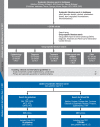Diagnosis, Treatment and Follow-up in Extracranial Carotid Stenosis
- PMID: 33549156
- PMCID: PMC7947643
- DOI: 10.3238/arztebl.2020.0801
Diagnosis, Treatment and Follow-up in Extracranial Carotid Stenosis
Abstract
Background: Around 15% of cerebral ischemias are caused by lesions of the extracranial carotid artery. The goal of this guideline is to provide evidence- and consensus-based recommendations for the management of patients with extracranial carotid stenoses throughout Germany and Austria.
Methods: A systematic literature search (1990-2019) and methodical assessment of existing guidelines and systematic reviews; consensus-based answers to 37 key questions with evidence-based recommendations.
Results: The prevalence of extracranial carotid artery stenoses is around 4% overall, higher from the age of 65 years. The most important examination modality is duplex sonography. Randomized trials have shown that carotid endarterectomy (CEA) significantly reduces the 5-year risk of stroke in patients with 60-99 % asymptomatic stenoses (absolute risk reduction [ARR] 4.1% over 5 years, number needed to treat [NNT] 24) or 50-99% symptomatic stenoses (50-69%: ARR 4.6 % over 5 years, NNT 22; 70-99%: 15.9 % over 5 years, NNT 6). With the aid of intensive conservative treatment, the carotid artery-associated risk of stroke can be reduced to as little as 1% per year. Critical determination of indications and strict quality criteria are therefore necessary for CEA and carotid artery stenting (CAS). Systematic reviews of controlled trials comparing CEA and CAS show that the procedural risk of stroke is higher for CAS (asymptomatic: 2.6% versus 1.3%; symptomatic: 6.2% versus 3.8%). There are no differences in the long term. CEA is recommended as standard procedure for high-grade asymptomatic and moderate to high-grade symptomatic carotid artery stenoses; CAS may be considered as an alternative. For both procedures, the periprocedural combined rate of stroke or death should not exceed 2% for asymptomatic stenoses or 4% for symptomatic stenoses.
Conclusion: Future studies should evaluate even better selection criteria for optimal individualized treatment, whether conservative, surgical, or endovascular.
Figures

Comment in
-
Grade of Stenosis Was Not Explained.Dtsch Arztebl Int. 2021 Apr 23;118(16):290. doi: 10.3238/arztebl.m2021.0145. Dtsch Arztebl Int. 2021. PMID: 34180792 Free PMC article. No abstract available.
References
-
- Eckstein HH KhA, Berkefeld J, Dörfler A, et al. S3-Leitlinie zur Diagnostik, Therapie und Nachsorge der extracraniellen Carotisstenose, Langfassung, Kurzfassung und Leitlinienreport. www.awmf.org/leitlinien/detail/ll/004-028.html: AWMF (Arbeitsgemeinschaft der Wissenschaftlichen Medizinischen Fachgesellschaften) 2020 [last accessed on 23 March 2020]
-
- Hadar N, Raman G, Moorthy D, et al. Asymptomatic carotid artery stenosis treated with medical therapy alone: temporal trends and implications for risk assessment and the design of future studies. Cerebrovasc Dis. 2014;38:163–173. - PubMed
Publication types
MeSH terms
LinkOut - more resources
Full Text Sources
Medical

